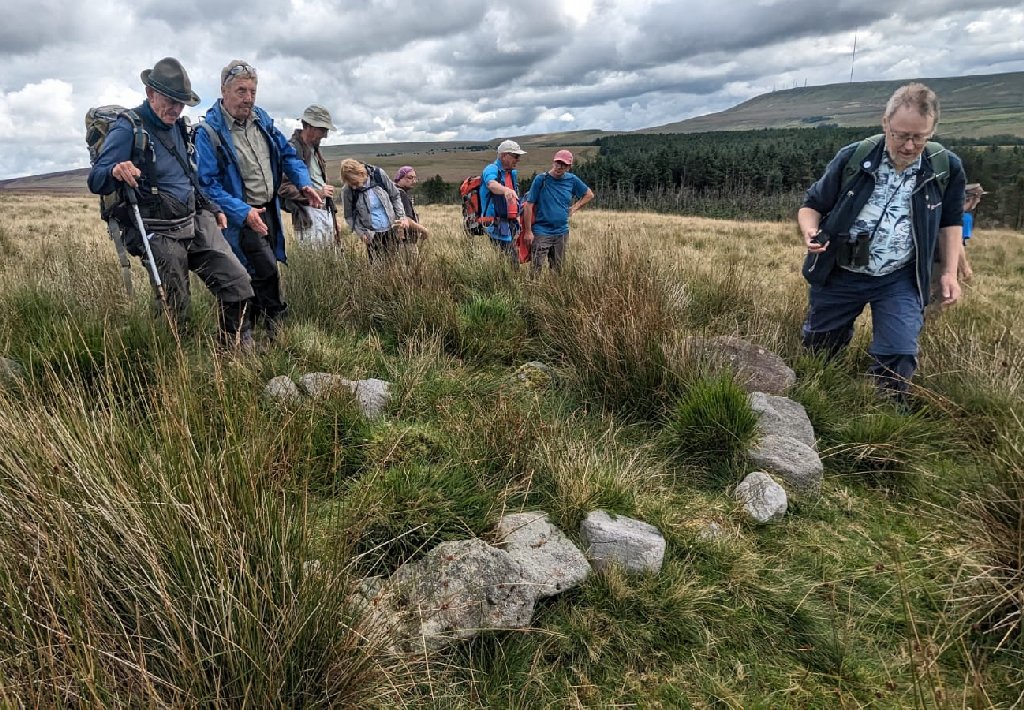This, our second trip of the season, was designed for our more active members and included some of the fascinating site on this historic and prehistoric landscape. Convening at Jepson’s Gate on Anglezarke Moor, he first leg of our walk took us into the very picturesque Lead Mines Clough, where our tour guides, Derek Cartwright and Garry Rhodes regaled us with stories of the mines and their history. It is not known when mining began here but the earliest recorded activity comes from the late 17th century. It’s heyday was in the early 18th century but even then it wasn’t a major operation mainly due to disputes between the various owners. Mining was abandoned in the early 19th century and it wasn’t until the 1980s that excavations reveal the remnants of the activities there. These included various pits, one housing a waterwheel that was used to pump out the water from the mines. As we went further a long the track we passed the monument to the flight crew of the Wellington Bomber that crashed on the moor in 1943. 
 We then struck out up the moor onto an area called Rushy Brow, where previously found microliths suggesting a site in the Mesolithic period, before circling round through some very boggy ground to an unnamed double-ring cairn.
We then struck out up the moor onto an area called Rushy Brow, where previously found microliths suggesting a site in the Mesolithic period, before circling round through some very boggy ground to an unnamed double-ring cairn.  Close by, we spotted another cairn, looking typically bronze age. From there we came down the moor to the celebrated chambered long cairn know as Pikestones. All that is left of this once huge monument (over 45 metres long) are the megaliths of the chamber itself.
Close by, we spotted another cairn, looking typically bronze age. From there we came down the moor to the celebrated chambered long cairn know as Pikestones. All that is left of this once huge monument (over 45 metres long) are the megaliths of the chamber itself.  It was first investigated by Dr Bu’lock in 1958 who suggest it was early Neolithic in date, having a concave front similar to the the long barrows found in Wiltshire. However the site was later re-examination by Frances Lynch in 1966 who could not detect the concave form and suggested it may belong to a group megalithic tombs found in Derbyshire.
It was first investigated by Dr Bu’lock in 1958 who suggest it was early Neolithic in date, having a concave front similar to the the long barrows found in Wiltshire. However the site was later re-examination by Frances Lynch in 1966 who could not detect the concave form and suggested it may belong to a group megalithic tombs found in Derbyshire.
It was a short walk back to the cars and after a quick lunch, we drove to our second location, parking at the junction of Rivington Road and Belmont Road. From there we had an uncomfortable walk some distance along the latter (as the road is unevenly cobbled) until we turned off for a rather stiff climb up to Noon Hill. Here there stands the bronze-age barrow excavated in 1958 by Bolton Archaeological Society .  The dig produced secondary cremation burials with tanged-and-barbed arrowheads and an enlarged food vessel of ‘hooped bucket’ type, all of which are now preserved in Bolton Museum. The barrow had two rings of stones one inside the other, the outer ring being about 16 metres in diameter and the inner one 10 metres and examination of the items found, indicated a late Bronze Age date (this site has particular significance for our site at Aspull).
The dig produced secondary cremation burials with tanged-and-barbed arrowheads and an enlarged food vessel of ‘hooped bucket’ type, all of which are now preserved in Bolton Museum. The barrow had two rings of stones one inside the other, the outer ring being about 16 metres in diameter and the inner one 10 metres and examination of the items found, indicated a late Bronze Age date (this site has particular significance for our site at Aspull).
The view was spectacular, with Anglesey, Great Orme, Liverpool docks and cathedral, Blackpool Tower, the Isle of Man and the Lake District hills all visible in one sweeping panorama. The trip was immensely enjoyed by all who took part, in no small way due to the knowledge and enthusiasm of our guides Derek and Garry.
